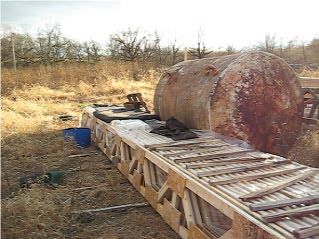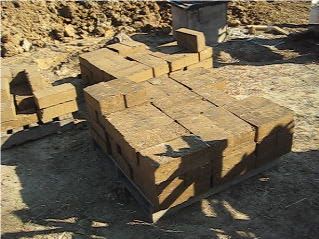from 2008.
We have finished laying gravel and insulation for the CEB addition foundation. It is a shallow insulated foundation, made with 2″ extruded polystyrene insulation going down 18 inches, plus 1 inch gravel as the fill. There is a drainage tube on the bottom. We excavated with the LifeTrac backhoe, which worked very well.
Edit in 2020: that is LifeTrac 1 doing the gravel hauling. Insulation was never put in because ground froze before we got to it. In 2020, the walls are standing strong, with minor shifting. Some spalling on CEBs under the overhang where horizontal rains can get to the CEBs. Worst artifact is a large animal that burrowed under wall to make a home, threatening wall integrity in that section. Periodic flooding occurs inside the workshop, as the floor is dug out 1 foot to accomodate more workshop height.
We also finished putting together 26 trusses, each 32 feet long. These are flat trusses for a living roof on the addition.
Meanwhile we’ve got hundreds of bricks pressed, and we’re waiting for the weather to clear up to press more. We’ll be pressing for about the next week. It’s really pushing it into the late season, and it’s raining right now. The bricks are covered – as they turn to a mudslide if they get wet. That is one of the challenges with CEB construction, we’re finding out. We’re planning on using stone sealer on the outside walls.




Great progress! You guys are really making it along.
A few pieces of advice:
Check out surface bonding for your bricks. No need for mortar, and construction is super fast. If you could design an interlocking pattern into the bricks, things would move even faster. A team of 4 can easily dry stack a house in 2 days.
Consider making lintel bricks for above windows and doors. A lintel brick looks like a U, and you fill the U with concrete a reinforcement. You can easily use them for bond beams as well, and that takes away needing to make wooden forms. It also is very fast with lintel bricks.
It is a shame that you are using wood for your roof. Your walls will last centuries, but those wooden trusses will be lucky to last 80 years. Instead of wood, use ferrocement or recycled steel. Ferrocement is best and can be built in place. It will last longer than your walls!
So great work, but there are a few minor things you should consider for the next building. You are definitely doing well, and once you get that roof sorted, you will have an awesome, low-cost building that could be built just about anywhere!
Abe, you seem quite knowledgeable on CEB construction – so here’s a working question. We Have a shallow insulated foundation with about 2 feet of gravel. We were going to stack water-sealed bricks right on top of that. We are experimenting with stone sealer, foundation waterproofer tar, and driveway sealer. We may try cement stucco. We seal the brick on all sides except the top side – so it could continue to cure. We will stack our wall right on top of this bottom layer. Do you see any issues with this strategy?
I would do a proper concrete footing with reinforcement, just for longevity, but your system will probably work. A lime stucco might be better suited to your application than concrete. You have to apply it more often, but it actually works better. Many times a concrete stucco on earthen blocks will flake off, mainly because water gets absorbed in the block, then forces a separation between the block and the concrete.
Concrete stucco and dry stack surface bond are 2 different things. Surface bond is reinforced with fibers, which makes it a lot stronger, but most of the time, it doesn’t have aggregate or sand, making it more water proof.
The thing about the gravel foundation is that eventually soil will build up on top of the gravel. This won’t be too big of an issue, but it does make the water move slower away from the wall. So, you need to keep this in mind with the bottom layer.
If it was me, I would do a concrete footing, reinforced, that is at least 9 inches thick, 12 inches wide. You can either set this in your gravel or make forms and put it on top (on top would be better for water). Then, I would set the first course of bricks in a mortar and get their tops level. Then, dry stack the rest of the wall on that, without mortar. Probably around the 4 ft high mark, you will want to set that course in mortar to get another level course (because of slight inconsistencies in the bricks, they will eventually get out of level after several courses). Then, at the top, do a concrete bond beam, reinforced, 9 inches thick and however wide the bricks are. Then you surface bond the interior and exterior with surface bond, which is cement, lime, fibers, and a few additives for water proofing. This goes on almost like paint, at about 1/8 thick. You can then paint with a latex paint to finish it out.
Then your wall is done and is several times stronger and more water proof than a regular mortared wall with either lime or concrete stucco.
I would then do a ferro cement roof to finish things off, and you have a building that will last for centuries with very little maintenance. It will also be completely fireproof. Ferro cement will work fine for an earth or sod roof on top, and is several times stronger and more durable than wood.
If you want more details, email me, and I can go over some of the finer details of this stuff.
Please provide more information on the ferrocement. Remember that we are putting a living roof on top of the building.
I’ve heard much about ferrocement – but I cannot conceptualize a replicable route to doing this for a roof. Please provide cost estimates and labor requirements.